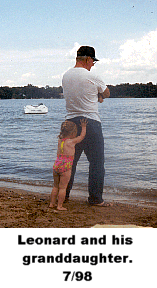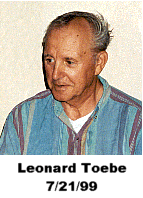Hardworking Family Man Concludes Platar Trial
The antique dealer and his wife Faye live in Johnson City, Wisconsin, on a street festooned with Green Bay Packers and Wisconsin Badgers flags. Two weeks into the current N.F.L. season, Faye said, "The Packers aren't playing together this year. They've gone back to the old days when they wait 'til the last quarter to play." (This assessment, sadly for Packers fans, has held to date). People know their football here, and they know how to enjoy life. The Toebes serve a comforting lunch of summer sausage and "string" cheese, and, if you're so inclined, a cold beer.
A former member of the International Brotherhood of Electrical Workers, the Construction and General Laborers Union, and the Building and Company Laborers Union of America, Len was exposed to asbestos products while working in the Merchant Marines in the Great Lakes, in commercial and residential construction, and as a factory worker. After that he put in 27 years as a drivers license examiner for the Department of Transportation with the State of Wisconsin . Seeking greater satisfaction in his work, Len left the State in 1997 to open up his own shop in an antique mall. Len enjoys woodworking, and built many of the pieces of furniture in their home.
Business was slow at first, as he expected, but he knew his patience would be rewarded. Patience, it seemed, was its own reward, as Len found a new fulfillment in his work and personal life. Len and Faye celebrated their 40th wedding anniversary this past August. The Toebes are a warm and close family. Len helped raise his 18 year-old grandson, who lives next door. Len acted as a "child care giver" to his smaller grandchildren. Life was good, and he even began getting more customers -- until May, 1999.
Towards the end of May, Len began to experience an irritating cough and shortness of breath performing simple outdoor tasks. Dr. Smith diagnosed Len with pneunomia and bronchitis. He prescribed antibiotics and sent Len home. Several weeks later on June 7 th, Len requested Dr. Smith to take chest films because Len believed the antibiotics were not working and something else needed to be done. On that day, Dr. Smith took several chest films and a CT scan that showed a right para-mediastinal mass associated with a right pleural effusion. A 4.0 centimeter mass was also noted in the right upper lobe. Dr. Smith sent Len home informing him that further testing should be considered. Len was referred to Dr. Chosy at the University of Wisconsin Pulmonology Clinic; however, he could not get an appointment for several months. The family was very worried and concerned that he would have to wait such a long period of time.

Len's symptoms remained and indeed worsened over the ensuing days. On June 13, Len was rushed to the emergency room at Fort Atkinson Memorial Hospital. Dr. Andrew Harris took additional chest films and noted a very large right pleural effusion. A thoracentesis was performed with minimal output, approximately 25 cc's of fluid. This fluid was submitted for cytological testing with a negative result.
Len was able to get his appointment with Dr. Chosy at the University of Wisconsin Pulmonology Clinic moved up. Dr. Chosy performed a bronchoscopy with biopsies. Pathological testing on this material yielded no diagnosis. On June 25, Len was admitted to the Fort Atkinson Hospital for a needle biopsy. A CT scan revealed a complete 'white out" of the right chest. Surgeon Dr. Kontny was unable to obtain enough biopsy tissue for pathological testing due to the large amount of fluid. A chest tube was then inserted. After four (4) days, the chest tube was removed and Len was sent home to await the cytology report. The June 29, cytology report reflects that cytological tests again were nondiagnostic. Meanwhile, Len suffered another fluid build-up in the right chest, and he continued to lose weight. He had lost about thirty (30) pounds in the preceding three (3) months. What was happening to this gentle, hard-working family man?
On July 10, Len Toebe underwent a pulmonary function test which revealed a "moderate restrictive lung disease." On July 15, Len was again admitted to Fort Atkinson Hospital, where Dr. Jonathan McLaughlin performed a thoracentesis and a thoracoscopy with lung and pleural biopsies. The biopsies would reveal the origin of Len's insidious decline. Pathologists at St. Mary's Laboratory in Madison, Wisconsin found the cause: diffuse malignant mesothelioma -- the term itself invokes a shudder of fright.
The surgeon informed the Toebes that there was nothing he knew of that could be done but he would refer them to an oncologist . He advised that surgery was not an option (read: "Since I don't know how to perform a pleurectomy / decortication, then it must be impossible"). They discussed chemotherapy and radiation as "possible" options. The Toebes were stunned by the doctor's assurance that surgery was not an option and that chemotherapy and radiation would not help . Like most of us, they had faith that in this day and age something could be done, so they contacted the University of Wisconsin Cancer Center in Madison, Wisconsin. The doctors there offered to remove the lung and pleura and follow up with radiation and chemotherapy (the "tri-modal therapy).
The Toebes however did not feel comfortable with a surgical option and began to research additional treatment options on their own. They discovered Dr. Roman Perez-Solar at the New York University Medical Center. Dr. Perez-Solar is heading the clinical research study involving the investigational drug, L-NDDP. After consulting with Dr. Perez-Solar, the Toebes elected to participate. The Toebes travelled from Wisconsin to New York City every three weeks until completion of the regimen. On October 21, 1999, Len Toebe completed the third and final cycle of the protocol, although they only administered 40 percent of the last dose.

Len has experienced some nausea and discomfort with the regimen, but not as severe as that reported with other forms of chemotherapy. It is believed that his CT scan report shows that his tumor has shrunk; however, the Toebes are currently having the report read by other specialists.
At this point, Dr. Perez-Solar is talking to the Toebes about trying one more treatment at a different site on Len's body. Len has had the tubes for administration of the chemotherapy removed, which relieves some of the pain and discomfort. He walks one to two miles, every day, and under the circumstances is hopeful. It should be mentioned that the Toebes' H.M.O. carrier has denied coverage for the costs of the treatment with Dr. Perez-Solar, which confounds and confuses the Toebes, who will appeal the bureaucratic decision.
On November 26, 1999, the Toebes consulted with Dr. Joan Schiller, Head of Oncology at the University of Wisconsin at Madison Medical Hospital. Wisconsin-Madison and M.D. Anderson are conducting a Phase I trial of Endostatin, an angiogenesis inhibitor. The Toebes understand that the aim of Endostatin is to kill the tumor by terminating the body's ability to grow new blood vessels, which in turn would deprive the nutrient-starved tumor of it's food supply. The Endostatin would be administered intravenously. Needle biopsies would be taken every day to monitor the success of the treatment. The Toebes are interested, but very cautious about entering "experimental" treatment.
Dr. Schiller reviewed the films and was less optimistic that the tumor had shrunk. In fact, Dr. Schiller's impression was that the tumor had advanced . Outside of surgery, and the experimental endostatin trial, the only conventionaltreatment option Dr. Schiller could recommend was gemcytabine. It remains to be seen whether Len will be eligible for pleurectomy or extra pleural pneumonectomy.
We wish the Toebes the best in their search for a cure, and will keep you posted.
*** POSTED DECEMBER 8, 1999 ***
An Update -- 4/5/00
The following are excerpts from e-mails written by Julie Gross, one of Leonard "Len" Toebe's daughters. As detailed above, Len chose administration of Platar chemotherapy with Dr. Roman Perez-Solar, which involved creation of surgical port sites. The Toebes want others to know of the risks associated with surgical port sites, specifically the risk that the cancer will "seed" or spread through the port.
The surgeon in Madison and the oncologist in Madison said mesothelioma is notorious for tracking out any surgical port sites. Tell newly diagnosed patients to be selective about any new holes made into the cancer site. Before Dad's decision to go to New York [for the Platar trial], we had asked two surgeons if this procedure would affect his surgical eligibility; they both said it would not cause a problem. They felt he would still be a surgical candidate after trying the N.Y. trial.
Since the treatment in N.Y. my Dad was tired, each treatment seemed to make this symptom a little worse. He was still able to function in some discomfort out in his workshop. He completed about a dozen hope chests for all of his grandchildren.
After the cancer appeared to be growing through the port sites, my Dad consulted with Dr. Joan Schiller of the University of Wisconsin-Madison, who tried to combat the cancer with twelve days of radiation therapy. Of course, the radiation therapy left Dad with even more fatigue. He will have his third CT scan, since surgery, on the 14th of April. The biopsy at surgery did conclude that he still has cancer cells.
Initially, the cancer looked to have grown on the CT scan, since the Platar treatment. Dr. Perez-Solar suggests that the chemo may have caused inflamation of the tissues. The direct application of the chemo will cause this. It is not possible to detect how much of this inflamation is actually cancer cells. Hopefully most of the inflamation on the CT scan is just dead tissue. The CT scans have not shown any change since the first CT scan after treatment. It has been about five months since Dad's last Platar treatment.
Dr. Schiller does not recommend trying to further combat the cancer with systemic chemotherapy until there is evidence of further growth. She suggests that because there are few treatment options for this disease, we need to pace ourselves in our battle against it. If we use up all of our options right away, then we will run out of time sooner.
Now Dad is struggling with different pain killers. He tried a patch that made him feel short of breath and he could not sleep. He also tried a longer working tablet that made him tremble all over. Both of these medications stayed in his system long enough to make him uncomfortable for over a week each.
At the present time Dad is beginning to feel very arthritic. He has trouble lifting his arms over his head. We think all of this trauma has triggered this. He did not have these symptoms before diagnosis. The physicians have not really addressed this problem. Dad has been experimenting with some complimentary medicines. He has seen an accupuncturist for a couple of months. She is also a nutritionalist who does homeopathy. She has been recommending a few subtle dietary changes and some supplements. This seems to have helped with my Dad's night sweats and other discomforts.
Dad's attitude has been great. He tries to walk a couple of miles a couple times a week and he continues to stock his booth at the antique store. (He is not able to do this as often as he would like, and he is not able to search for new stock hardly at all.) He tries to keep life as normal as he can. Some days are better than others. My Mom has been a strong support for him. This has played a toll on her health. Her blood pressure is rising. She also had a CT scan because of her repeat bouts of pneumonia. These scans came back normal, thankfully. Dad is weighing in at about 157 pounds. Before diagnosis he weighed about 200 pounds. He looks frail and worn-out. He seems to be feeling better again since his conflict with pain medication and radiation.
I would like to add that all of the medical staff associated with Dad's treatment at N.Y.U. were very warm and personable. Dr. Perez-Solar spent a great deal of time discussing my father's disease with us over the phone. I feel they are on the right track. If only the treatment could be given with a less invasive means to monitor its effectiveness.
We wish the Toebes the best in their continuing struggle with mesothelioma.
An Update -- 2/6/01
We received the following update from Leonard's daughter, Julie:
If you have other patients looking for alternatives, let them know that I have talked to Dr. Hedy Kindler at University of Chicago, about her study of the SU5416 specifically for mesothelioma and she has told me that her early impressions of this treatment are very exciting! She has seen reduction of tumor. This is a phase 2 and you can only have had one type of systematic chemotherapy regime. Intrapleural treatments are also acceptable.
There needs to be at least 10mm of viable tumor that is not with in any radiation field. We were disappointed to find out that my Dad no longer was eligible because there was not a conclusively unradiated area of at least 10mm. The treatment is very well tolerated, very few side effects. You would be required to have 2 infusion a week.(Mon/Thurs. or Tues/Fri) She also spoke about a possible Gemcitabine/SU5416 trial in the works. But, of course they would not allow you in the trial if you have already had either of these drugs. I think this is a very promising treatment.
Dad is planning to start treatment of the ALIMTA (R) (pemetrexed disodium) in Indianapolis in the beginning of March. We are hopeful this will buy him time and make him feel better. Dr. Hedy Kindler's research assistant is Kathleen Chien. I was told her father also had Mesothelioma. She is very kind and helpful. E-mail: kchien@medicine.bsd.uchicago.edu or office phone #- (773)834-3137 My Dad was also experiencing tinitus and hearing loss due to the Cisplatin/Gemcitabine treatment he had undergone. This is very common with this treatment and he now has a hearing aid that has been very helpful in relieving this problem. Some ENT clinics may even provide previously owned hearing aids at no cost to cancer patients on a loaner basis. He no longer tunes out to conversations around him. The hearing loss is usually in the higher pitches. So it is difficult to hear children and women. I recommend patients to get a hearing test done before treatment so there is a base line evaluation.
From Leonard's daughter, Julie:
My Father passed away in his sleep. The cancer had spread to his better lung and was slowly decreasing his breathing capacity. Almost two years after diagnosis. He fought a long hard battle with optimism and courage. The treatments he tried took a toll on him and while the treatments didn't save him, he helped to contribute to a possible cure for others. He was very brave. We miss him and treasure our memories of him.
Now we have our anger to deal with. These people that are responsible for his death have no idea of all the pain they have caused him, his family and friends. The last two years have been a kind of hell you can't describe in words. None of our lives will ever be the same.
Those of you who have been newly diagnosed, stay optimistic. I feel they are close to a treatment. The last treatment my Dad was undergoing was ALIMTA (R) (pemetrexed disodium) . This treatment was well tolerated, but unfortunately it was not effective on him. He also participated in the L-NDDP(platar) trial, cisplatin/gemcitabine and radiation of the surgical port. If you have further questions about our experience with these treatments, please write me pjgross@tds.net I would be happy to share my insights. Best wishes.
*** POSTED APRIL 24, 2001 ***


